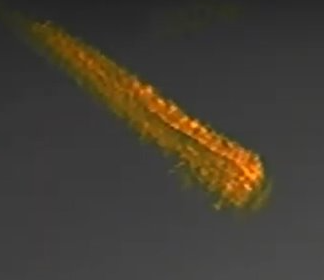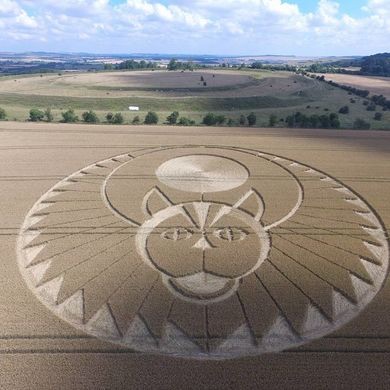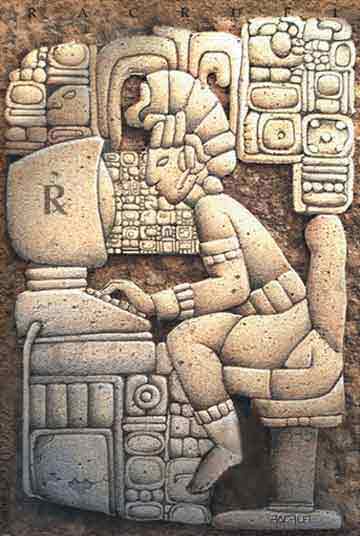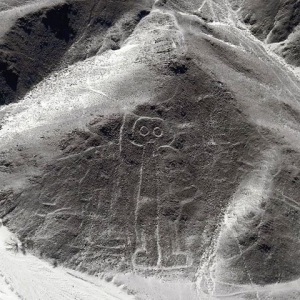HUEYATLACO … 250,000 YEAR OLD SETTLEMENT IN MEXICO FOUND UNDER VOLCANIC ASH
Hueyatlaco: 250,000 Year Old Settlement In Mexico Found Under Volcanic Ash
Hueyatlaco is an archeological site in Valsequillo, Mexico. Several potential pre-Clovis localities were found in the 1960s around the edge of the Valsequillo Reservoir, Mexico. One of these localities is the site of Hueyatlaco. This site was excavated by Cynthia Irwin-Williams in 1962, 1964, and 1966.
The Hueyatlaco Archeological Site is situated on the Tetela Peninsula, along the north shore of the Valsequillo reservoir in the State of Puebla, Mexico, approximately 100 km southeast of Mexico City and 10 km south of the City of Puebla.
In the 1960s, highly sophisticated stone tools rivaling the best work of Cro-magnon man in Europe were unearthed by Professor Juan Armenta Camacho and Dr. Cynthia Irwin-Williams at Hueyatlaco, near Valsequillo.

After excavations in the 1960s, the site became notorious due to geochronologists’ analyses that indicated human habitation at Hueyatlaco was dated to ca. 250,000 years before the present.
Professor Juan Armenta Camacho

Beds containing human artifacts at Valsequillo, Mexico, have been dated at approximately 250,000 years before the present by fission-track dating of volcanic material and uranium dating of a camel pelvis. The dilemma posed by such dates is clearly stated in the following quotation from the conclusions of the subject article.
“The evidence outlined here consistently indicates that the Hueyatlaco site is about 250,000 yr old. We who have worked on geological aspects of the Valsequillo area are painfully aware that so great an age poses an archeological dilemma. If the geological dating is correct, sophisticated stone tools were used at Valsequillo long before analogous tools are though to have been developed in Europe and Asia. Thus, our colleague, Cynthia Irwin-Williams, has criticized the dating methods we have used, and she wishes us to emphasize that an age of 250,000 yr is essentially impossible.”
(Steen-McIntyre, Virginia, et al; “Geologic Evidence for Age of Deposits at Hueyatlaco Archeological Site, Valsequillo, Mexico,” Quaternary Research, 16:1, 1981.)
Credit: mcremo.com
These controversial findings are orders of magnitude older than the scientific consensus for habitation of the New World (which generally traces widespread human migration to the New World to 13,000 to 16,000 ybp). The findings at Hueyatlaco have mostly been repudiated by the larger scientific community, and have seen only occasional discussion in the literature
Ostrander skull to the rignt, allegedly from the Hueyatlaco Site. On the left a modern skull

Credit: Austin Whittall patagoniamonsters.blogspot.com
Cynthia Irwin-Williams led the team that first excavated the site in 1962 The dig is often associated with Virginia Steen-McIntyre because of her continuing efforts to publicize her findings and opinions. However, the site was actually discovered by Juan Armenta Camacho and Irwin-Williams. Steen-McIntyre joined the team in 1966 as a graduate student, at the request of project geologist Hal Malde. The excavation was associated with the U.S. Geological Survey.
The region, about 75 miles SE of Mexico City, was known for its abundance of animal fossils, and Irwin-Williams described Hueyatlaco as a “kill site” where animals were hunted and butchered.
These tools are believed to be 250,00 years old from the Hueyatlaco site.

Credit: Dr. Cynthia Irwin-Williams/H.S. Rice
Excavations were conducted via standard protocols, including securing the sites to prevent trespass or accidental disturbances. During excavation, investigators discovered numerous stone tools. The tools ranged from relatively primitive implements at a smaller associated site, to more sophisticated items such as scrapers and double-edged blades uncovered at the main excavation site. The diversity of tools made from non-local materials suggested that the region had been used by multiple groups over a considerable period.

Credit: Chris Hardaker
In 1967, Jose L. Lorenzo of the Instituto Nacional de Antropología e Historia claimed that implements had been planted at the site by local laborers in such a way as to make it difficult or impossible to determine which artifacts were discovered in situ and which were planted. Irwin-Williams counter-argued that Lorenzo’s claims were malicious and without merit. Furthermore, in 1969 Irwin-Williams cited statements of support from three prominent archeologists and anthropologists (Richard MacNeish, Hannah Marie Wormington and Frederick A. Peterson) who had each visited the site independently and attested to the integrity of the excavations and the professionalism of the group’s methodology

Credit: Chris Hardaker
In mid-1969, Szabo, Malde and Irwin-Williams published their first paper about dating the excavation site. The stone tools were discovered in situ in a stratum that also contained animal remains. Radiocarbon dating of the animal remains produced an age of over 35,000 ybp. Uranium dating produced an age of 260,000 ybp, ± 60,000 years.
The site had been buried by the ash of Popocatépetl, the volcano is also called Popo

Credit: Wikipedia
The authors admitted that they had no definitive explanation for the anomalous results. However, Malde suggested the tool-bearing strata had possibly been eroded by an ancient streambed, thus combining older and newer strata and complicating dating.

Credit: Chris Hardaker
In 1973, Steen-MacIntyre, Malde and Roald Fryxell returned to Hueyatalco to re-examine the geographic strata and more accurately determine an age for the tool-bearing strata. They were able to rule out Malde’s streambed hypothesis. Moreover, the team undertook an exhaustive analysis of volcanic ash and pumice from the original excavation site and the surrounding region. Using the zircon fission-track dating method, geochemist C.W. Naeser dated samples of ash from Hueyatlaco’s tool-bearing strata to 370,000 ybp +/- 240,000 years.
The confirmation of an anomalously distant age for human habitation at the Hueyatlaco site led to tension between Irwin-Williams and the other team members. Malde and Fryxell announced the findings at a Geological Society of America meeting, admitting that they could not account for the anomalous results. Irwin-Williams responded by describing their announcement as “irresponsible”. Given the substantial margin of error for the fission-track findings, and the then-new method of uranium dating, Irwin-Williams asserted that Hueyatlaco had not been accurately dated to her satisfaction.

Credit: Chris Hardaker
Excerpt of letter to Marie Wormington from Dr. Cynthia Irwin-Williams [circa 1969]:
“…Meanwhile, I recently got a letter from Hal, with some (completely wild) uranium dates on Valsequillo material. I don’t see how he can take them seriously since they conflict with the archaeology, with his own geologic correlations, and with a couple C14 dates. However, God help us, he wants to publish right away! I am enclosing a copy of Hal’s letter and my reply. Needless to say any restraint you can exercise on him would be greatly appreciated. All we need to do at this point is to put that stuff in print and every reputable prehistorian in the country will be rolling in the aisles.”
On March 30, 1981, Steen-McIntyre wrote to Estella Leopold, the associate editor of Quaternary Research: “The problem as I see it is much bigger than Hueyatlaco. It concerns the manipulation of scientific thought through the suppression of ‘Enigmatic Data,’ data that challenges the prevailing mode of thinking. Hueyatlaco certainly does that! Not being an anthropologist, I didn’t realize the full significance of our dates back in 1973, nor how deeply woven into our thought the current theory of human evolution had become. Our work at Hueyatlaco has been rejected by most archaeologists because it contradicts that theory, period.”
Eventually, Quaternary Research (1981) published an article by Virginia Steen-McIntyre, Roald Fryxell, and Harold E. Malde. It upheld an age of 250,000 years for the Hueyatlaco site. Cynthia Irwin-Williams (1981) objected to these findings in a letter responding to these authors. Her objections were answered point-for-point in a counter letter from Malde and Steen-McIntyre (1981).

Credit: Chris Hardaker
The case of Virginia Steen-McIntyre opens a rare window into the actual social processes of data suppression in paleoanthropology, processes that involve a great deal of hurt and conflict. In general, however, this goes on behind the scenes, and the public sees only the end result—the carefully edited journals and books that have passed the censors.
In recent times the Hueyatlaco Site has been reinvestigated by Dr. Sam VanLandingham using diatom dating methodology to confirm the anomalously old dates assigned by Malde, Steen-McIntyre and Fryxell:
The diatom biostratigraphy presented herein establishes a minimum (Sangamonian) and a maximum (Illinoian) age for the younger (bifacial) artifacts at the Hueyatlacoarchaeological site in units B,C, and E, Puebla, Mexico.
VanLandingham used diatom biostratigraphy in determining a minimum (Sangamonian = 80,000–ca.220,000 yr. BP) and a maximum (Illinoian = 220,000–430,00 yr. BP) age for the Hueyatlaco artifacts, Puebla, Mexico. Nova Hedwigia (February, 2009), Beiheft 135, p. 15-36.
Quoting the Abstract: The diatom biostratigraphy presented herein establishes a minimum (Sangamonian) and a maximum (Illinoian) age for the younger (bifacial) artifacts at the Hueyatlaco archaeological site in units B,C, and E, Puebla, Mexico. One of the 13 samples in this study is from a position of Sangamonian age which is stratigraphically higher than the artifacts. The minimum age of this sample (from unit B) is demonstrated by 6 taxa which became extinct at the end of the Sangamonian , and its maximum age (also Sangamonian) is denoted by 3 taxa with earliest known first occurrences in the Sangamonian. The diatoms of the remaining 12 samples have a minimum age of Sangamonian. Three of the 13 samples are in unit I and no Hueyatlaco artifacts are known below this unit.
____________________________
Sources:
http://www.bibliotecapleyades.net/ciencia/esp_ciencia_life18.htm
http://csfa.tamu.edu/research.php
http://valsequillo.earthmeasure.com/
^ Szabo, B.J., Malde, H.E., and Irwin-Williams, C., Dilemma Posed By Uranium-Series Dates On Archaeologically Significant Bones From Valsequillo Puebla Mexico, Earth and Planetary Science Letters, Volume 6, Pages 237-244, Jul 1969
^ Gonzalez, Silvia; Huddart, David; and Bennett Matthew. (2006) Valsequillo Pleistocene archaeology and dating : ongoing controversy in Central Mexico . World Archaeology, 2006, vol. 38, no4, pp. 611-627.
^ a b Irwin-Williams, C., et al., Comments on the Associations of Archaeological Materials and Extinct Fauna in the Valsequillo Region Puebla Mexico, American Antiquity, Volume 34, Number 1, Pages 82-83, Jan 1969
^ Irwin-Williams, Cynthia. (1978) Summary of Archeological Evidence from the Valsequillo Region, Puebla, Mexico. In Cultural Continuity in Mesoamerica, David L. Browman, ed. The Hague: Mouton Publishers.
^ a b c d e f g h Webb, Mark Owen and Suzanne Clark. (1999). “Anatomy of an Anomaly .” Disputatio, 6.
^ Szabo, B.J., Malde, H.E., and Irwin-Williams, C., Dilemma Posed By Uranium-Series Dates On Archaeologically Significant Bones From Valsequillo Puebla Mexico, Earth and Planetary Science Letters, Volume 6, Pages 237-244, Jul 1969
^ Steen-McIntyre, V., R. Fyxell and H. Malde. (1981) Geologic Evidence for Age Deposits at Hueyatlaco Archaeological Site Valsequillo Mexico, Quaternary Research, Number 16, Pages 1-17, 1981
^ http://www.xmission.com/~tlacy/mom.txt
^ VanLandingham, S.L., Corroboration of Sangamonian Age of Artifacts From the Valsequillo Region Puebla Mexico By Means of Diatom Biostratigraphy, Micropaleontology, Volume 50, Number 4, Pages 313-342, 2004
^ VanLandingham, S.L., Diatom Evidence For Autocthonous Artifact Deposition In the Valsequillo Region Puebla Mexico During Sangamonian (sensu lato = 80,0000 to ca. 220,000 yr BP and Illinoian (220,000 to 430,000 yr BP)), Journal of Paleolimnology, Volume 36, Number 1, Pages 101-116, Jul 2006
http://ancientstuff.maxforum.org/2012/09/09/evidence-for-modern-humans-in-americas-250000-year/
http://valsequillo.earthmeasure.com/Val3/content/Slide07_large.html
http://patagoniamonsters.blogspot.com/2011/01/ostrander-skull-supposedly-erectus.htm
.
.








































Ho conosciuto l’esistenza di Hueyatlaco grazie al libro Archeologia proibita di Cremo e Thompson (The hidden history of the human race). Comprendo le dure opposizioni tra chi sostiene teorie differenti, però, per completezza di informazione, bisognerebbe esporre i differenti pareri in merito, invece emerge una visione dominante che, senza ragione, vuole togliere voce ad ogni alternativa. Occorre approdare ad un modo di fare ricerca e scienza più umile e meno dogmatico.
LikeLike